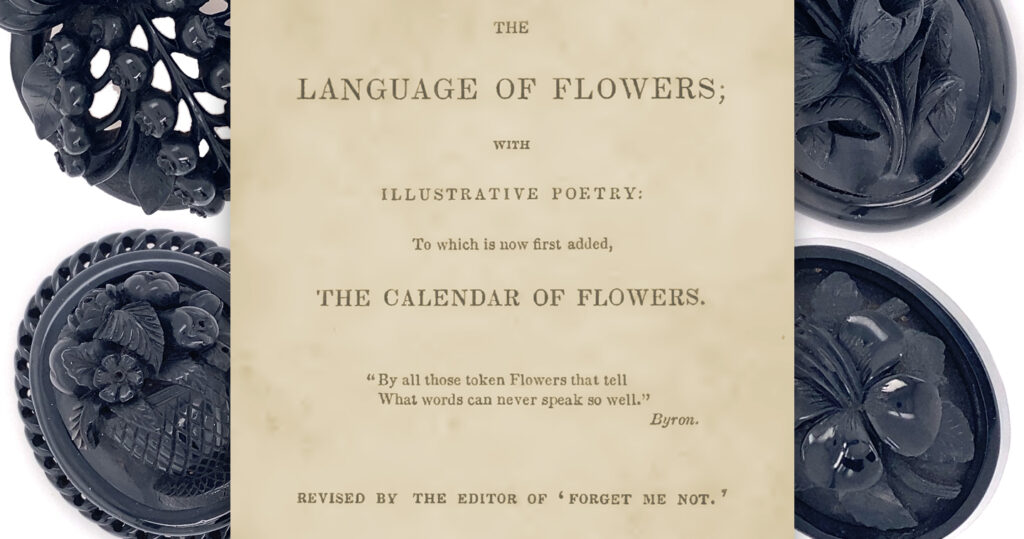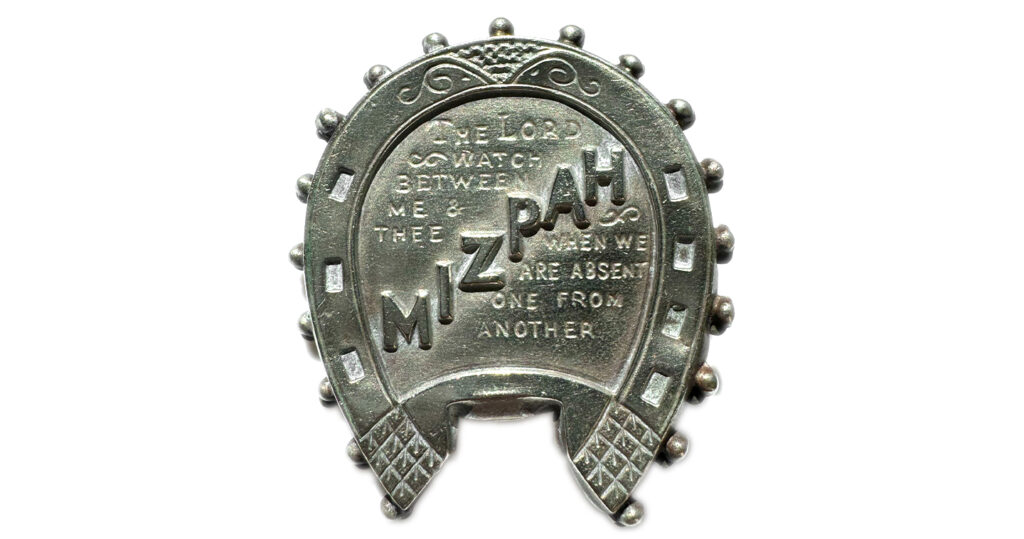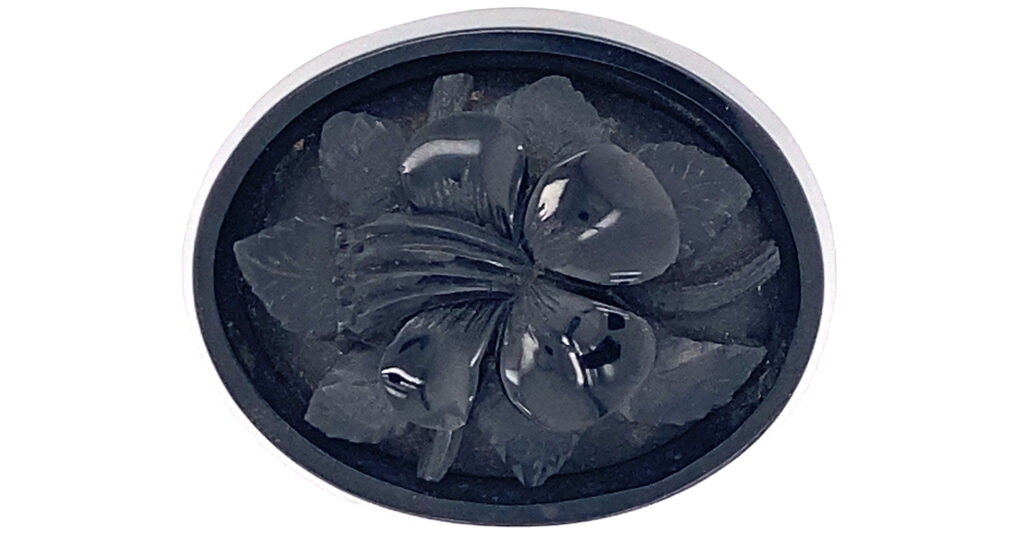Wheat Symbolism in Jewels

The Museum of Whitby Jet is a genuine establishment of living history. Combined with the store W. Hamond, it presents the oldest connection to 19th century Whitby Jet manufacture that still exists. It is a tribute to the 1500 men and 200 shops that existed in 1873 to produce the finest quality of Jet available in the world. Their craft, of carving, turning and polishing jet held a standard that set the British Empire beyond any other jet industry in the world, being held in the highest regard by Queen Victoria herself.
Due to the popularity of Whitby Jet, the instances of its carving designs are almost infinite. The Victorians relished the romantic and sentimental language of flowers. They were educated, had access to new wealth and were the first affluent middle class that could afford leisure time. Travel was a part of seasonal Victorian lifestyle and cottage industries emerged with the connection of rail lines that ferried these sentimental people across Britain. Whitby’s popularity as the centre of Jet fed its local community and its economy. Carvers were charged with appealing to the most popular designs from the visitors, who requested sentimental tokens to gift to their loved ones.
This Art of Mourning series is in partnership with the Museum of Whitby Jet and is a look at the jewels of the museum through the eyes of the Victorians who requested and understood the love language of flowers.
To achieve this, part 1 of the series is an introduction to Whitby Jet, which can be read below:
Link > Discover Whitby Jet
Part 2 is an understanding of ‘floriography’, a late 18th and 19th century attempt by philosophers and writers to connect floral discoveries of the world to emotion to empirical fact. This can be read below:
Link > Understanding Symbolism: Botany and Floriography
Symbolism of Wheat

Abundance is an interesting insight into the Victorian psyche. The classical revivals of the 1860s allowed for the integration of archaeological designs in discoveries into architecture, art and jewellery. Many of these classical figures and elements relate to prosperity, wealth and strength. The integration of gods and figures such as Dionysus, (wine, ecstatic rites, fertility), Apollo (music, poetry, purity and light), Ares (war), Zeus (king of gods, weather, fertility) and Hermes (messenger, commerce, science, travel) in cameo, intaglio and carved designs added value to the wearer of a jewel, beyond aesthetic value. Demeter/Ceres, the goddess of harvest and fertility, is depicted by a stalk of wheat or grain, which relates back to the symbolism of riches. The cultivation of wheat is the bedrock of civilisation. A successful harvest feeds the people and this symbol of work, growth, wealth and success relates directly to the lifestyles of the middle classes in the 19th century, who would give and wear the jewels that depicted wheat.
Bread is symbolically linked to Christian beliefs, with its connection to the physical body of Christ:
Mark 14:22-24
New International Version
22 While they were eating, Jesus took bread, and when he had given thanks, he broke it and gave it to his disciples, saying, “Take it; this is my body.”
23 Then he took a cup, and when he had given thanks, he gave it to them, and they all drank from it.
24 “This is my blood of the[a] covenant, which is poured out for many,” he said to them.
Wheat sheafs have been connected to the jewels of love, life and death, as the connotations of life, growth and success also represent the life of a loved one. When seen in 18th century mourning jewels, the harvest of the sheafs being cut can be seen, often with the sheafs made from human hair. The life is cut short, but the values of prosperity and the richness of new life in heaven is symbolically linked to the divine harvest.

RICHES.
Wheat. – Triticum.
“Of golden wheat, the strength of human life.” Philips.
loral hieroglyphics have not a more appropriate emblem than that of representing riches by this gift of Ceres.
Without content no man can be rich, and it will always be found that there is a greater
proportion of wealthy poor people, than of rich in content.
“What riches give us, let us first enquire,
Meat, fire, and clothes; what more? meat, clothes, and
fire.”
Pope.
Floral Emblems, p. 270

CORN is a term applied to all sorts of grain fit for food, particularly wheat, barley, oats, and rye. All of them belong to the grand division of grasses, which are distinguished from other plants by their simple, straight, unbranched stalk, hollow, and jointed, commonly called straw; with long, narrow, tapering leaves, placed at each joint of the stalk, and sheathing and enclosing it, as if by way of support.
Ceres, the goddess of corn and harvest, was represented with a garland of ears of corn on her head, the commemoration of the loss of her daughter Proserpine was celebrated about the beginning of harvest; that of her search after her at the time of sowing corn.
This plant, together with the use of fire, seems to have been bestowed by Providence on man, in order to secure to him the dominion of the earth. With corn and fire, he may dispense with all other gifts, or rather, he may acquire them all. With corn alone he can feed, all the domestic animals, which furnish him with subsistence or share his labours. Corn is the first bond of society, because its culture and preparation demand hard labour and mutual services.
The Language of Flowers, p.171

Wheat Stalk… Riches.
The Illustrated Language of Flowers, p.63






